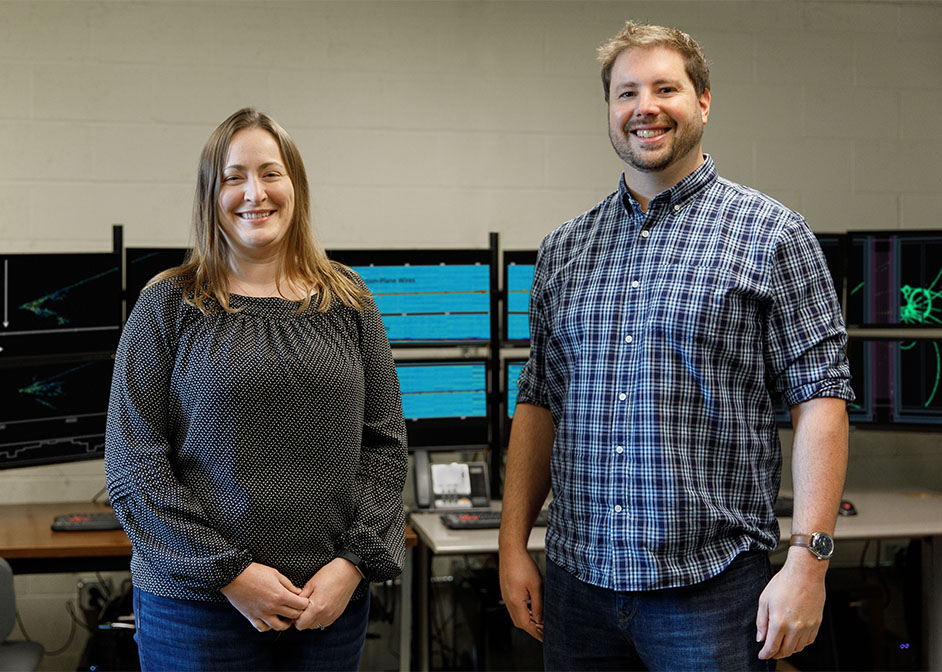Funding Awarded by the Department of Energy Office of Science
Understanding how our vast universe works often begins with a knowledge of the fundamental particles that are the building blocks of what we can see, touch, smell and taste. Those particles are not just protons, neutrons and electrons, but include the tiny neutrino, the most abundant massive particle in the universe. Yet the nature of the neutrino remains elusive to physicists and is exactly why University of Houston researchers are working to learn more about it.

For example, there is a “missing link” in the Big Bang theory of the origin of the universe. The Big Bang requires equal parts of matter and antimatter to have been created. But the observable universe today is composed, almost exclusively, of matter. Figuring out where the antimatter went is one of the biggest open questions in physics today.
The U.S. Department of Energy’s Office of Science awarded University of Houston physics professors Lisa Koerner and Daniel Cherdack $1.5 million to study neutrino oscillations over the course of three years. The UH physicists work with collaborators around the world on experiments hosted at Fermilab, CERN and J-PARC, particle physics and accelerator laboratories in the US, Europe and Japan, respectively. Their efforts are building towards the success of the next-generation Deep Underground Neutrino Experiment or DUNE, which is currently being constructed in the US. DUNE includes a beam of neutrinos, created by Fermilab’s accelerator complex, that will travel about 800 miles from Fermilab, located near Chicago, to DUNE’s far detector being constructed in South Dakota.
The main goal of this work is to understand the behavior of neutrinos, which behave differently when they traverse time and space independently, and when they interact with matter,” said Koerner, who is on the faculty of the UH College of Natural Sciences and Mathematics. “We describe traveling neutrinos as quantum mechanical superpositions of the interacting states and vice-versa. This property causes neutrinos to change the way they interact over time. The first observations of this so-called ‘flavor changing’ behavior known as neutrino oscillations won the 2015 Nobel prize in physics.”
Koerner, Cherdack and their team will continue to investigate neutrino oscillations, specifically comparing the oscillations for both neutrinos and their antimatter counterpart, antineutrinos.
“If we observe different oscillation properties for neutrinos and antineutrinos, then we will have found a new source of CP violation, or a difference between the way matter particles and anti-matter particles interact.” said Cherdack “Finding CP violation in neutrinos will have implications about the theory of the Big Bang, the fact that time only goes in one direction and why the set of known fundamental particles is larger than required to build most of the matter in the universe.”
Work Funds Additional Neutrino Experiments
The team will also contribute to DUNE by conducting work on atmospheric neutrinos, which are essentially neutrinos that come from cosmic rays hitting the upper atmosphere, proton decay and research and development at DUNE’s smaller Near Detector Complex, located on-site at Fermilab.
“We have a general design in mind for this near detector but there are still prototyping efforts that we are involved with, such as test measurements,” Koerner said. “The probability of a neutrino interacting is pretty small. There are a lot of neutrinos in the beam and only a small fraction actually interact with the detector, but those are the ones we study.”
Additionally, the award funds other experiments Koerner and Cherdack are a part of: NOvA (Koerner), T2K (Cherdack) and ICARUS (Cherdack). NOvA and T2K are currently running neutrino oscillation experiments; Koerner and Cherdack will study neutrino interactions with data from these two experiments and may combine their analysis to better inform their measurement of neutrino oscillation probability. ICARUS uses the same type of detector as DUNE and is designed to search for sterile neutrinos. Cherdack will study neutrino interactions in ICARUS and make measurements of how neutrinos interact to better predict what will happen with DUNE’s larger scale version of the detector technology.
These experiments will provide hardware development and data analysis opportunities for UH students and postdocs while also addressing physics questions that are important for DUNE.